UNCC300 - Justice and Change: Nursing Education Discrimination
VerifiedAdded on 2023/01/18
|5
|1053
|100
Essay
AI Summary
This essay, written for the UNCC300 course on Justice and Change in the Global World, analyzes discrimination in nursing education as a significant challenge both locally and globally. The paper explores various forms of discrimination, including those based on social status, disability, race, and gender, providing examples from Australia and other countries. It highlights the exclusion of students with disabilities, racial bias against African American students, and gender stereotypes in nursing. The essay then connects the course material, specifically community engagement, human dignity, and principles of advocacy, to potential solutions for addressing these issues. It emphasizes the importance of equal opportunities, mutual relationships, respect for human rights, and advocating for vulnerable individuals. The essay references several academic sources to support its arguments and concludes by underscoring the need to combat discrimination in education to promote justice and the common good.
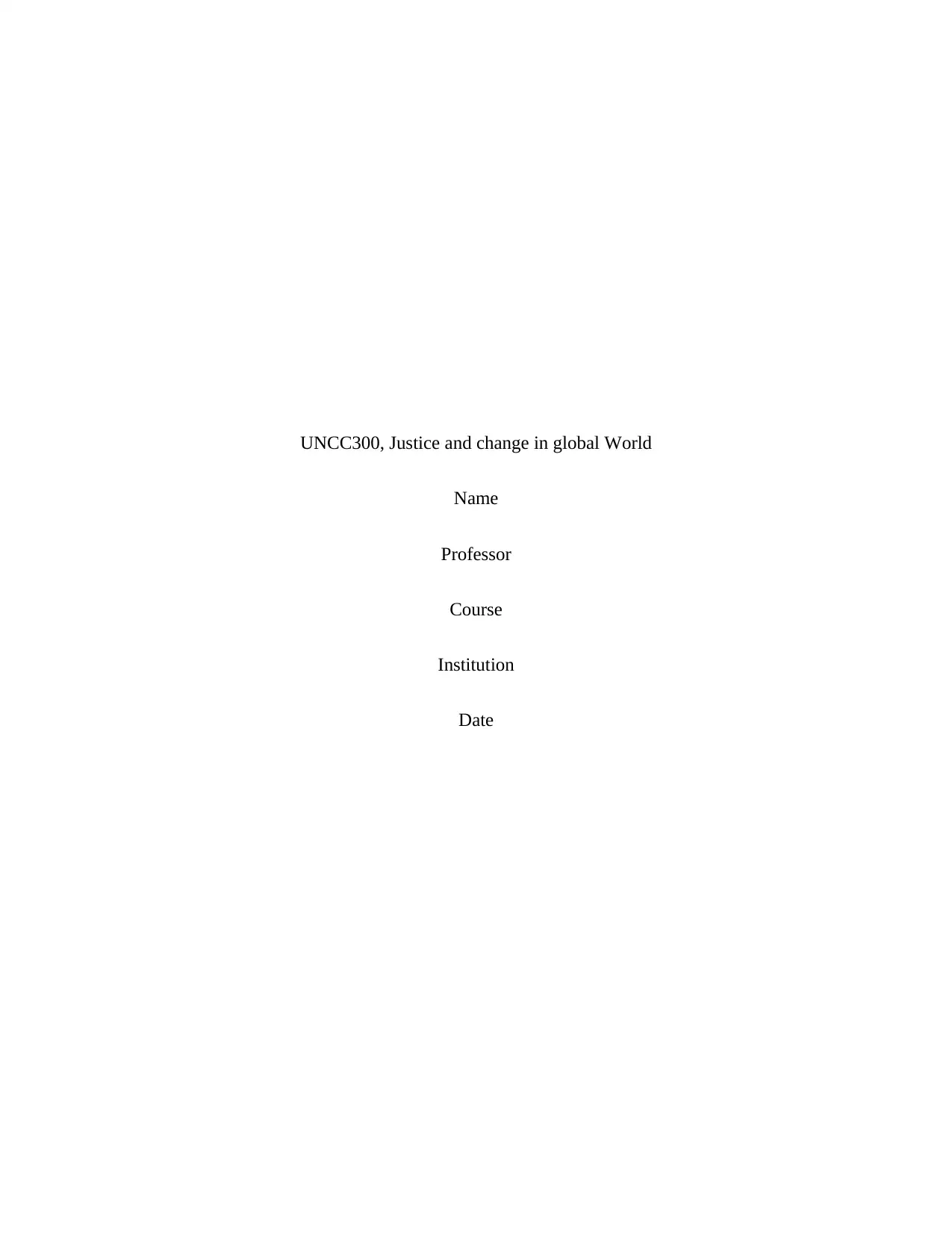
UNCC300, Justice and change in global World
Name
Professor
Course
Institution
Date
Name
Professor
Course
Institution
Date
Paraphrase This Document
Need a fresh take? Get an instant paraphrase of this document with our AI Paraphraser
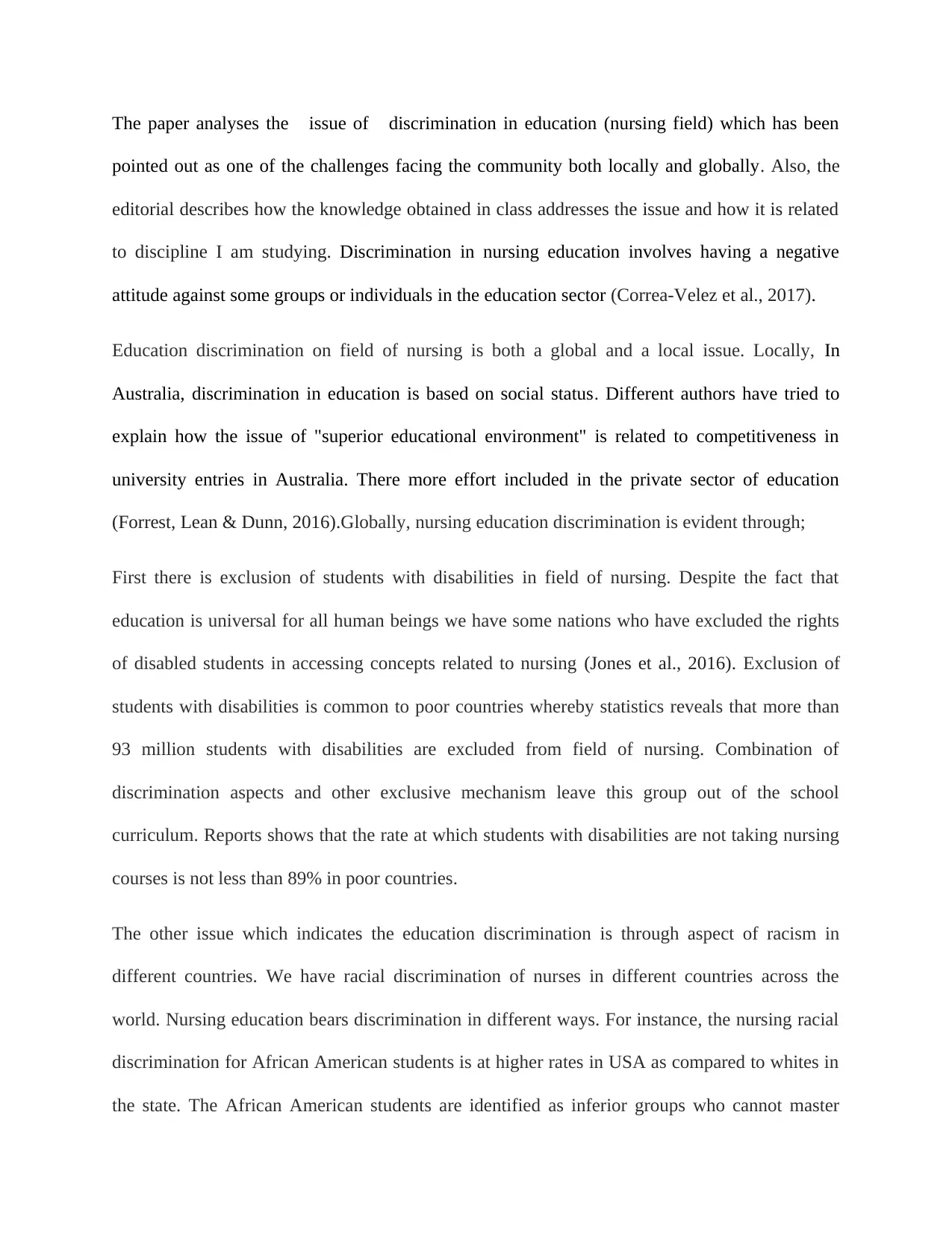
The paper analyses the issue of discrimination in education (nursing field) which has been
pointed out as one of the challenges facing the community both locally and globally. Also, the
editorial describes how the knowledge obtained in class addresses the issue and how it is related
to discipline I am studying. Discrimination in nursing education involves having a negative
attitude against some groups or individuals in the education sector (Correa-Velez et al., 2017).
Education discrimination on field of nursing is both a global and a local issue. Locally, In
Australia, discrimination in education is based on social status. Different authors have tried to
explain how the issue of "superior educational environment" is related to competitiveness in
university entries in Australia. There more effort included in the private sector of education
(Forrest, Lean & Dunn, 2016).Globally, nursing education discrimination is evident through;
First there is exclusion of students with disabilities in field of nursing. Despite the fact that
education is universal for all human beings we have some nations who have excluded the rights
of disabled students in accessing concepts related to nursing (Jones et al., 2016). Exclusion of
students with disabilities is common to poor countries whereby statistics reveals that more than
93 million students with disabilities are excluded from field of nursing. Combination of
discrimination aspects and other exclusive mechanism leave this group out of the school
curriculum. Reports shows that the rate at which students with disabilities are not taking nursing
courses is not less than 89% in poor countries.
The other issue which indicates the education discrimination is through aspect of racism in
different countries. We have racial discrimination of nurses in different countries across the
world. Nursing education bears discrimination in different ways. For instance, the nursing racial
discrimination for African American students is at higher rates in USA as compared to whites in
the state. The African American students are identified as inferior groups who cannot master
pointed out as one of the challenges facing the community both locally and globally. Also, the
editorial describes how the knowledge obtained in class addresses the issue and how it is related
to discipline I am studying. Discrimination in nursing education involves having a negative
attitude against some groups or individuals in the education sector (Correa-Velez et al., 2017).
Education discrimination on field of nursing is both a global and a local issue. Locally, In
Australia, discrimination in education is based on social status. Different authors have tried to
explain how the issue of "superior educational environment" is related to competitiveness in
university entries in Australia. There more effort included in the private sector of education
(Forrest, Lean & Dunn, 2016).Globally, nursing education discrimination is evident through;
First there is exclusion of students with disabilities in field of nursing. Despite the fact that
education is universal for all human beings we have some nations who have excluded the rights
of disabled students in accessing concepts related to nursing (Jones et al., 2016). Exclusion of
students with disabilities is common to poor countries whereby statistics reveals that more than
93 million students with disabilities are excluded from field of nursing. Combination of
discrimination aspects and other exclusive mechanism leave this group out of the school
curriculum. Reports shows that the rate at which students with disabilities are not taking nursing
courses is not less than 89% in poor countries.
The other issue which indicates the education discrimination is through aspect of racism in
different countries. We have racial discrimination of nurses in different countries across the
world. Nursing education bears discrimination in different ways. For instance, the nursing racial
discrimination for African American students is at higher rates in USA as compared to whites in
the state. The African American students are identified as inferior groups who cannot master
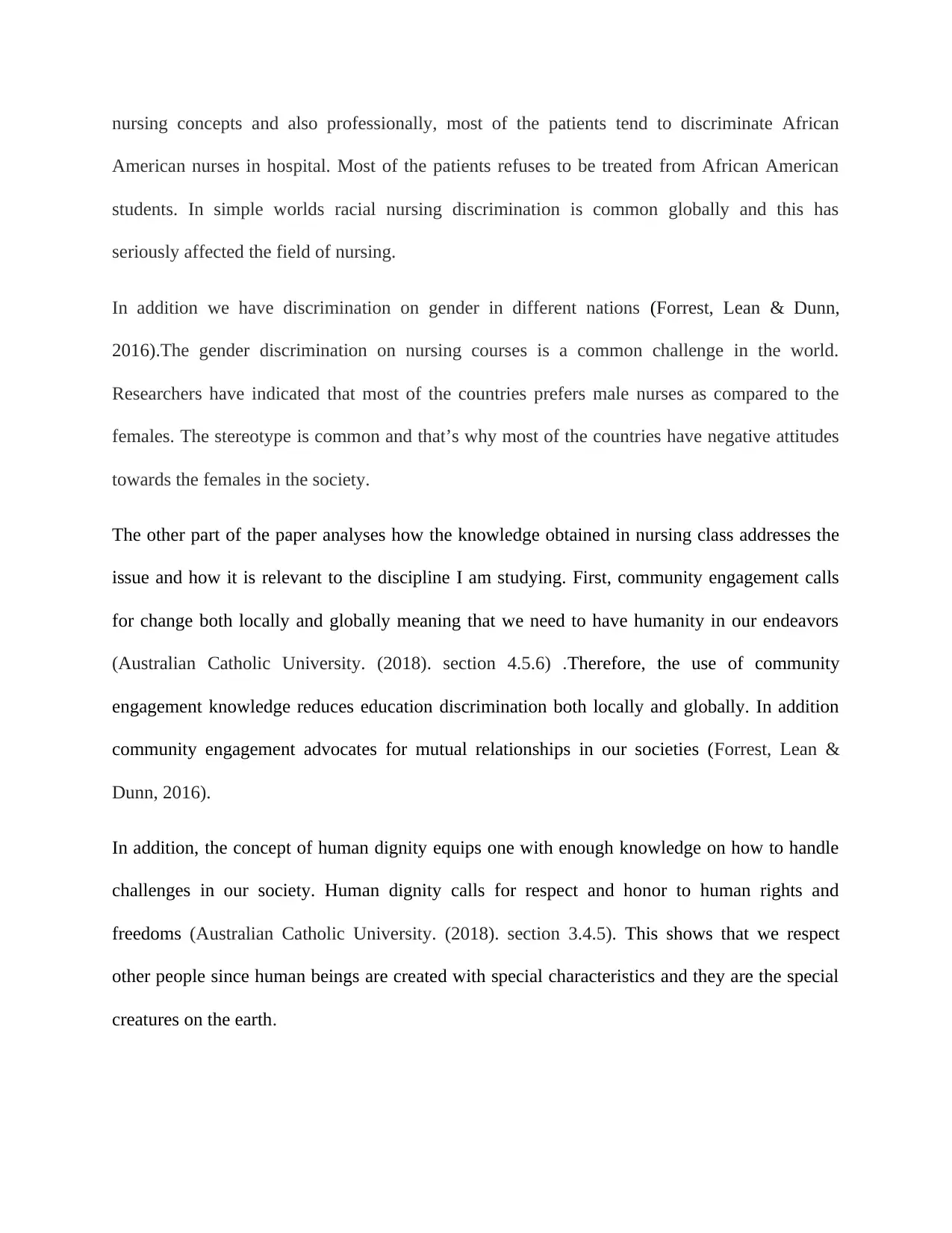
nursing concepts and also professionally, most of the patients tend to discriminate African
American nurses in hospital. Most of the patients refuses to be treated from African American
students. In simple worlds racial nursing discrimination is common globally and this has
seriously affected the field of nursing.
In addition we have discrimination on gender in different nations (Forrest, Lean & Dunn,
2016).The gender discrimination on nursing courses is a common challenge in the world.
Researchers have indicated that most of the countries prefers male nurses as compared to the
females. The stereotype is common and that’s why most of the countries have negative attitudes
towards the females in the society.
The other part of the paper analyses how the knowledge obtained in nursing class addresses the
issue and how it is relevant to the discipline I am studying. First, community engagement calls
for change both locally and globally meaning that we need to have humanity in our endeavors
(Australian Catholic University. (2018). section 4.5.6) .Therefore, the use of community
engagement knowledge reduces education discrimination both locally and globally. In addition
community engagement advocates for mutual relationships in our societies (Forrest, Lean &
Dunn, 2016).
In addition, the concept of human dignity equips one with enough knowledge on how to handle
challenges in our society. Human dignity calls for respect and honor to human rights and
freedoms (Australian Catholic University. (2018). section 3.4.5). This shows that we respect
other people since human beings are created with special characteristics and they are the special
creatures on the earth.
American nurses in hospital. Most of the patients refuses to be treated from African American
students. In simple worlds racial nursing discrimination is common globally and this has
seriously affected the field of nursing.
In addition we have discrimination on gender in different nations (Forrest, Lean & Dunn,
2016).The gender discrimination on nursing courses is a common challenge in the world.
Researchers have indicated that most of the countries prefers male nurses as compared to the
females. The stereotype is common and that’s why most of the countries have negative attitudes
towards the females in the society.
The other part of the paper analyses how the knowledge obtained in nursing class addresses the
issue and how it is relevant to the discipline I am studying. First, community engagement calls
for change both locally and globally meaning that we need to have humanity in our endeavors
(Australian Catholic University. (2018). section 4.5.6) .Therefore, the use of community
engagement knowledge reduces education discrimination both locally and globally. In addition
community engagement advocates for mutual relationships in our societies (Forrest, Lean &
Dunn, 2016).
In addition, the concept of human dignity equips one with enough knowledge on how to handle
challenges in our society. Human dignity calls for respect and honor to human rights and
freedoms (Australian Catholic University. (2018). section 3.4.5). This shows that we respect
other people since human beings are created with special characteristics and they are the special
creatures on the earth.
⊘ This is a preview!⊘
Do you want full access?
Subscribe today to unlock all pages.

Trusted by 1+ million students worldwide
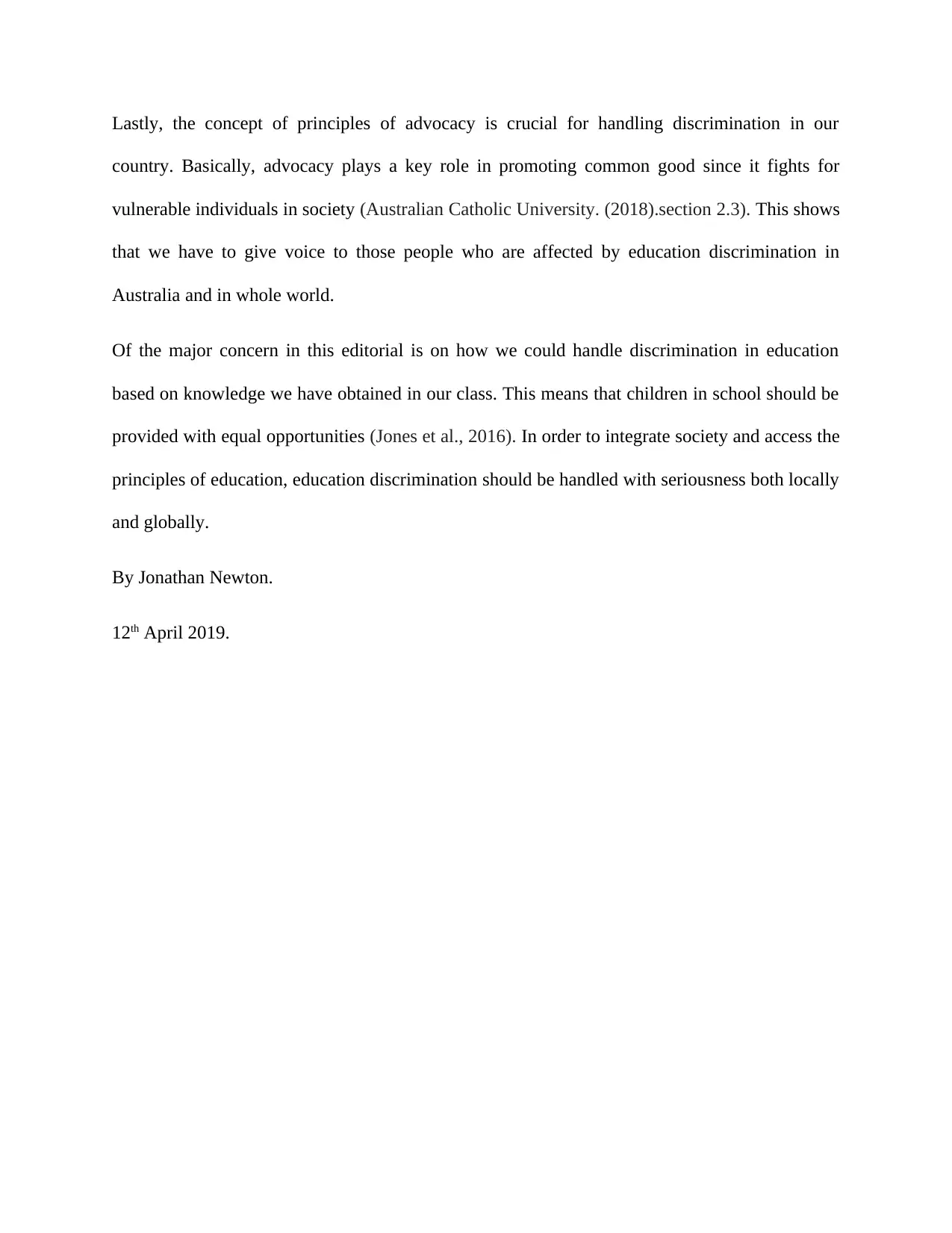
Lastly, the concept of principles of advocacy is crucial for handling discrimination in our
country. Basically, advocacy plays a key role in promoting common good since it fights for
vulnerable individuals in society (Australian Catholic University. (2018).section 2.3). This shows
that we have to give voice to those people who are affected by education discrimination in
Australia and in whole world.
Of the major concern in this editorial is on how we could handle discrimination in education
based on knowledge we have obtained in our class. This means that children in school should be
provided with equal opportunities (Jones et al., 2016). In order to integrate society and access the
principles of education, education discrimination should be handled with seriousness both locally
and globally.
By Jonathan Newton.
12th April 2019.
country. Basically, advocacy plays a key role in promoting common good since it fights for
vulnerable individuals in society (Australian Catholic University. (2018).section 2.3). This shows
that we have to give voice to those people who are affected by education discrimination in
Australia and in whole world.
Of the major concern in this editorial is on how we could handle discrimination in education
based on knowledge we have obtained in our class. This means that children in school should be
provided with equal opportunities (Jones et al., 2016). In order to integrate society and access the
principles of education, education discrimination should be handled with seriousness both locally
and globally.
By Jonathan Newton.
12th April 2019.
Paraphrase This Document
Need a fresh take? Get an instant paraphrase of this document with our AI Paraphraser
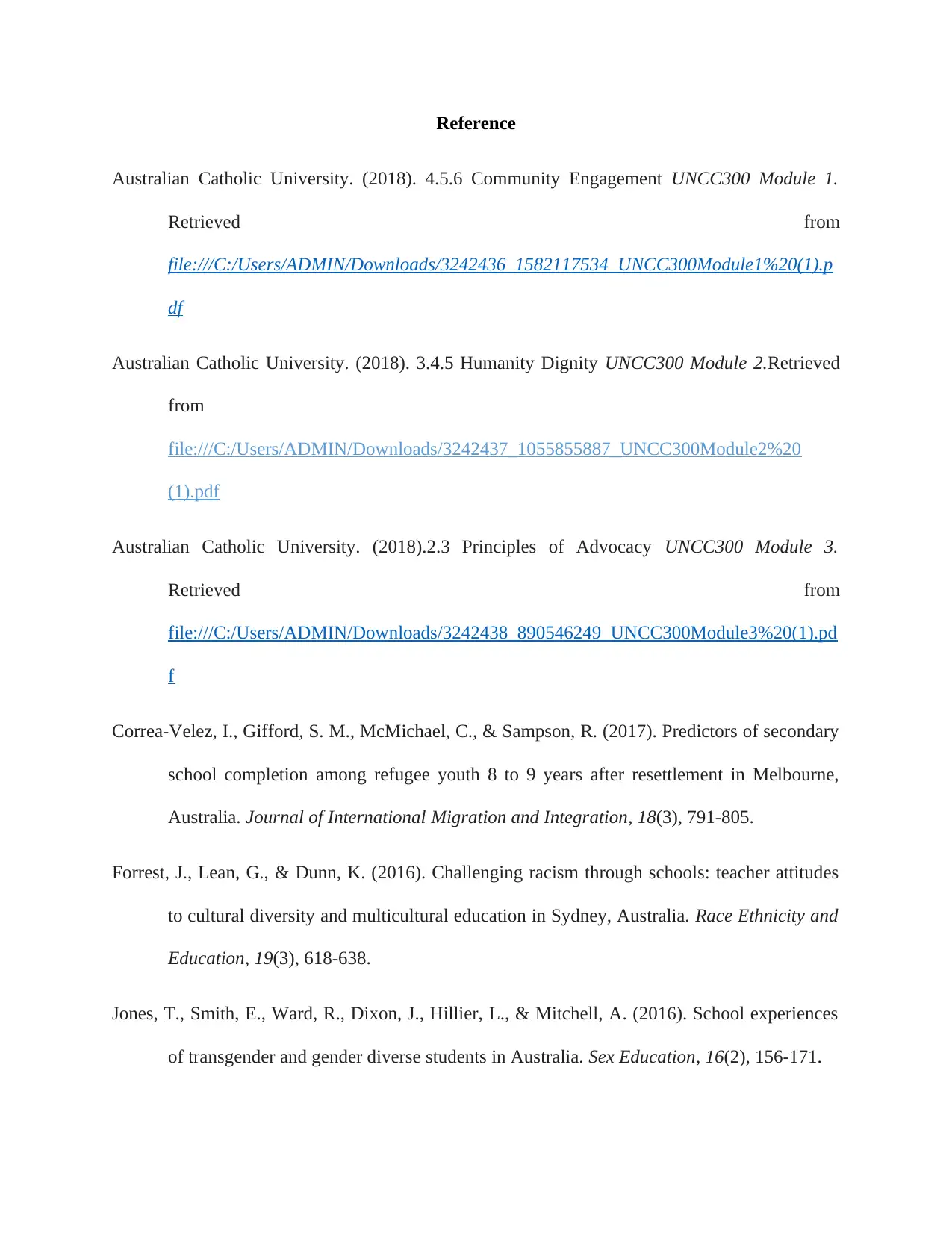
Reference
Australian Catholic University. (2018). 4.5.6 Community Engagement UNCC300 Module 1.
Retrieved from
file:///C:/Users/ADMIN/Downloads/3242436_1582117534_UNCC300Module1%20(1).p
df
Australian Catholic University. (2018). 3.4.5 Humanity Dignity UNCC300 Module 2.Retrieved
from
file:///C:/Users/ADMIN/Downloads/3242437_1055855887_UNCC300Module2%20
(1).pdf
Australian Catholic University. (2018).2.3 Principles of Advocacy UNCC300 Module 3.
Retrieved from
file:///C:/Users/ADMIN/Downloads/3242438_890546249_UNCC300Module3%20(1).pd
f
Correa-Velez, I., Gifford, S. M., McMichael, C., & Sampson, R. (2017). Predictors of secondary
school completion among refugee youth 8 to 9 years after resettlement in Melbourne,
Australia. Journal of International Migration and Integration, 18(3), 791-805.
Forrest, J., Lean, G., & Dunn, K. (2016). Challenging racism through schools: teacher attitudes
to cultural diversity and multicultural education in Sydney, Australia. Race Ethnicity and
Education, 19(3), 618-638.
Jones, T., Smith, E., Ward, R., Dixon, J., Hillier, L., & Mitchell, A. (2016). School experiences
of transgender and gender diverse students in Australia. Sex Education, 16(2), 156-171.
Australian Catholic University. (2018). 4.5.6 Community Engagement UNCC300 Module 1.
Retrieved from
file:///C:/Users/ADMIN/Downloads/3242436_1582117534_UNCC300Module1%20(1).p
df
Australian Catholic University. (2018). 3.4.5 Humanity Dignity UNCC300 Module 2.Retrieved
from
file:///C:/Users/ADMIN/Downloads/3242437_1055855887_UNCC300Module2%20
(1).pdf
Australian Catholic University. (2018).2.3 Principles of Advocacy UNCC300 Module 3.
Retrieved from
file:///C:/Users/ADMIN/Downloads/3242438_890546249_UNCC300Module3%20(1).pd
f
Correa-Velez, I., Gifford, S. M., McMichael, C., & Sampson, R. (2017). Predictors of secondary
school completion among refugee youth 8 to 9 years after resettlement in Melbourne,
Australia. Journal of International Migration and Integration, 18(3), 791-805.
Forrest, J., Lean, G., & Dunn, K. (2016). Challenging racism through schools: teacher attitudes
to cultural diversity and multicultural education in Sydney, Australia. Race Ethnicity and
Education, 19(3), 618-638.
Jones, T., Smith, E., Ward, R., Dixon, J., Hillier, L., & Mitchell, A. (2016). School experiences
of transgender and gender diverse students in Australia. Sex Education, 16(2), 156-171.
1 out of 5
Related Documents
Your All-in-One AI-Powered Toolkit for Academic Success.
+13062052269
info@desklib.com
Available 24*7 on WhatsApp / Email
![[object Object]](/_next/static/media/star-bottom.7253800d.svg)
Unlock your academic potential
Copyright © 2020–2025 A2Z Services. All Rights Reserved. Developed and managed by ZUCOL.





